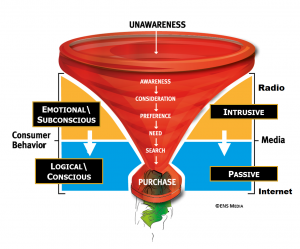Media Marketing Funnel
The marketing funnel explains the process of how consumers move from unawareness at the top of the funnel to awareness, and from purchase intent to purchase at the bottom of the funnel. It also explains the process of recognizing a need for establishing a brand preference.
To understand the marketing communications funnel, we must first understand two underlying marketing communications principles:
- The roles of emotion and logic in consumer behavior.
- The unique compatible roles of intrusive media and passive media.

Emotions First
Consumers seldom understand their purchase behavior. They believe their purchases are logical, rational, and well thought out, but seldom is this the case.
In reality, consumers buy emotionally from the heart first and only justify their purchase decisions using rational and logic.
Intrusive Media First
Passive media are those media that require you to consciously stop what you are doing and actively seek out before they can influence you. Passive media are primarily print, brochures, websites, and yellow pages. You must already have an awareness of, or have identified a need for, a product or service before you will take time to search for and absorb the passive media message.
You won’t search the web or yellow pages for a tire store if you don’t need tires, and you certainly won’t take time out of your busy day to read a tire ad if you don’t need tires.
Intrusive media, on the other hand, are those media that reach and influence consumers while they go about their daily activities, be it driving in their cars or watching TV. Only intrusive media, primarily radio and TV, can penetrate the consumer’s thoughts before they are in the market for a product and before they have entrenched opinions and brand preferences.
Passive media can only reach people who are “ready to buy”. In reality, however, you won’t be part of the passive media search if you’re not in the funnel. At that point, it’s too late to create a trust or preference after consumers are ready to buy, but you need the passive media to justify and rationalize the consumer’s buying decision.
The Perfect Bundle: Radio Inspires – Internet Informs
Marketing influence begins at the top of the marketing communications funnel, moving consumers from unawareness to need recognition, then down to brand preference and purchase. Businesses that do not capture consumers at the top end of the marketing funnel cannot be one of the finalists considered at the purchase end of the funnel.
Consumers enter the top end of the funnel emotionally, and almost unknowingly, while they only search passive media when they are ready to buy; after intelligent marketers have already created an awareness and preference for their products.
Radio’s intrusiveness can influence consumers at both the entrance of the funnel and at the purchase end of the funnel. Adding online products and mobile promotions can multiply our delivery at the ready-to-purchase end of the funnel beyond anything our passive media friends can ever deliver.
Like the old yellow page directories in the phone book, people search the web for three basic reasons:
- To look up a business they already have in mind to learn more about them or find their contact information, or
- To search for multiple businesses in a category where no marketer has effectively established their brand and the consumer could not think of a business in that category, or
- To shop multiple businesses for the cheapest price (not a good business strategy).
Intrusive media, like radio or TV, can be the SEO in all three areas.
- Creative intrusive campaigns will create an emotional connection, awareness, and preference for a particular business long before a need arises.
- Open categories, categories where most consumers have no awareness of or preference for a particular business, are prime categories where intrusive media can easily and inexpensively create a dominant share of mind and share of market for businesses who aim to be that category’s leader.
- When prices are virtually comparable, intrusive branding and awareness can be the tiebreaker for your advertisers over their competitors.
Advertisers who rely upon “the luck of the draw” or the premise of first up is first bought, are tickling themselves to hear themselves laugh. Research shows that people are 70% more likely to click on a business or product they are familiar with over someone they do not know.
Even if a search ranks your site early today, it is also quite simple for surfers to find and click on your competitors’ sites as well.
Smart marketers today use an integrated media approach, rather than putting all of their eggs in the online basket.
If you would like a FREE marketing consultation contact us today!
If you would like a FREE Digital Assessment of your Business, fill out the form here!
At Titan Broadcasting and Digital Group, our success is based on making you successful too!
Recent Comments